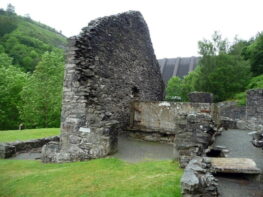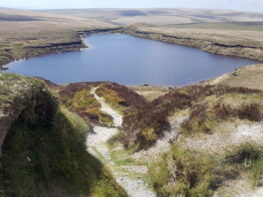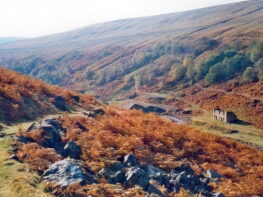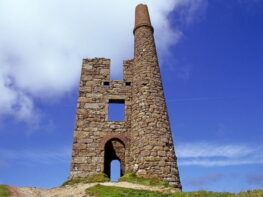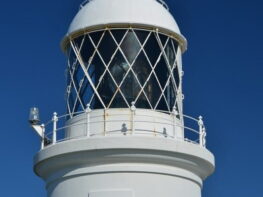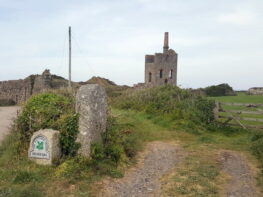
The Bell Pits on Rudland Rigg are located high up on the Yorkshire Moors.
The coal was intensively mined on the high Moors from Medieval times.
The bell pits can easily be missed at ground level, while walking along the Rudland Rigg track, to the North of Gillamoor – an old drove road that runs north-south over the North York Moors.
The bell pits are where poor quality coal was dug from the bedrock.
The coal seams were probably very shallow and lay beneath approximately 12 feet (4 metres) of shale and rocky overburden. A central shaft was sunk into the coal seam, and from this shaft a chamber of coal was excavated and hauled to the surface by a pony or manually-operated winch. Wooden props would’ve been used to support the roof for a limited distance from the central shaft but then, as the cavity became extended and the danger of a roof fall increased, the pit would be abandoned and left to collapse or subside under the weight of the overlying rock and shale.
Locals have mined Alum, Iron, Jet (the black mineral famous for Whitby jewelry), building stone, and coal.
The demand for coal in the early 1800s could not have been met by using the poor quality coal that was available locally at Rudland, and also at Piethorn, (north of Carleton) and at Hamer House, which lies on the moor tops between Egton and Rosedale Abbey. Mining these coal seams started early in the 1730s. Men and women, and no doubt children, mined coal from over one hundred bell-pits set out in a grid over a wide area east and west of Rudland Rigg.
The last miner, a man called Green, obtained coal to fire a steam threshing machine during the General Strike in the 1920s.
Transport difficulties made it too difficult to get coal into the region, before modern roads and the coming of the railways. Local people were forced to dig the narrow seam of coal that runs below the higher moors above Danby and Rosedale; and between Brandsdale and Farndale.
The coal was of such low grade, however, that it became commonly known as “Danby Crackers” due to its tendency to splutter and explode in the hearth.
The mounds are the spoil heaps from hundreds of bell-pits which were dug to reach the coals. The bell-pits are arranged in lines and the galleries below ground would have joined together during mine-working. This arrangement was thought to have aided ventilation below ground where the air was fouled by coal vapour and poison gas.
Interestingly, the remnants of the coal mines only exist today because of the poor quality of the coal.
Had the coal been of better quality, the Victorians would have turned to more intensive mining methods which would have destroyed all traces of the earlier Medieval industry on the Moors.
The best location to see the remains of the historic Medieval coal mines on the North York Moors is on Rudland Rigg; between Farndale and Bransdale. To access Rudland Rigg from Rosedale Abbey, drive to the village of Gillamoor (Postcode = YO62 7HU). Read about the walk – HERE!
Probably best to get out of the car and take a (careful) look, or better still, get in a plane!
Near Low Mill, North Yorkshire
Grid Ref: SE 6583 9401

The Bell Pits on Rudland Rigg are located high up on the Yorkshire Moors.
The coal was intensively mined on the high Moors from Medieval times.
The bell pits can easily be missed at ground level, while walking along the Rudland Rigg track, to the North of Gillamoor – an old drove road that runs north-south over the North York Moors.
The bell pits are where poor quality coal was dug from the bedrock.
The coal seams were probably very shallow and lay beneath approximately 12 feet (4 metres) of shale and rocky overburden. A central shaft was sunk into the coal seam, and from this shaft a chamber of coal was excavated and hauled to the surface by a pony or manually-operated winch. Wooden props would’ve been used to support the roof for a limited distance from the central shaft but then, as the cavity became extended and the danger of a roof fall increased, the pit would be abandoned and left to collapse or subside under the weight of the overlying rock and shale.
Locals have mined Alum, Iron, Jet (the black mineral famous for Whitby jewelry), building stone, and coal.
The demand for coal in the early 1800s could not have been met by using the poor quality coal that was available locally at Rudland, and also at Piethorn, (north of Carleton) and at Hamer House, which lies on the moor tops between Egton and Rosedale Abbey. Mining these coal seams started early in the 1730s. Men and women, and no doubt children, mined coal from over one hundred bell-pits set out in a grid over a wide area east and west of Rudland Rigg.
The last miner, a man called Green, obtained coal to fire a steam threshing machine during the General Strike in the 1920s.
Transport difficulties made it too difficult to get coal into the region, before modern roads and the coming of the railways. Local people were forced to dig the narrow seam of coal that runs below the higher moors above Danby and Rosedale; and between Brandsdale and Farndale.
The coal was of such low grade, however, that it became commonly known as “Danby Crackers” due to its tendency to splutter and explode in the hearth.
The mounds are the spoil heaps from hundreds of bell-pits which were dug to reach the coals. The bell-pits are arranged in lines and the galleries below ground would have joined together during mine-working. This arrangement was thought to have aided ventilation below ground where the air was fouled by coal vapour and poison gas.
Interestingly, the remnants of the coal mines only exist today because of the poor quality of the coal.
Had the coal been of better quality, the Victorians would have turned to more intensive mining methods which would have destroyed all traces of the earlier Medieval industry on the Moors.
The best location to see the remains of the historic Medieval coal mines on the North York Moors is on Rudland Rigg; between Farndale and Bransdale. To access Rudland Rigg from Rosedale Abbey, drive to the village of Gillamoor (Postcode = YO62 7HU). Read about the walk – HERE!
Probably best to get out of the car and take a (careful) look, or better still, get in a plane!
Near Low Mill, North Yorkshire
Grid Ref: SE 6583 9401


